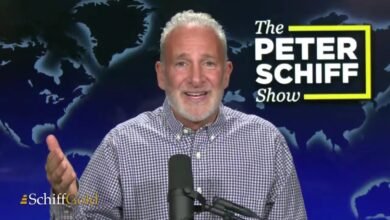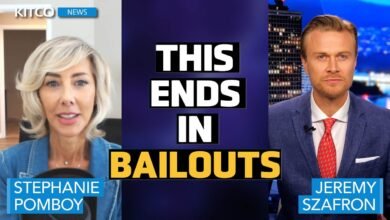The Opportunity In Gold & Silver Is NOT Over (Uncut) 04-14-2025
The Opportunity In Gold & Silver Is NOT Over – Mike Maloney & Alan Hibbard
You said something that like the opportunity isn’t over. And once upon a time, I put this chart together, you can look at the time on the bottom. This is basically the year 1979.
So these are the different months of 1979. And that, of course, was the end, the final year of the 1970s bull market. And the price of gold more than doubled, you know, in that calendar year, it was like 125% or something like that.
So imagining, you know, the price of gold doubling in a calendar year, that’s that’s amazing. And I just worked backwards from the final day of the bull market. And I sort of had this question of how long did it take for the final doubling to happen? And from the final price of 873, if you go back 42 days, the price was 431.
So it took 42 days for it to double at the very end. And then if you go back before that, you know, the tripling, you know, ignore the doubling, and then just say the tripling was 166 days, so less than six months, and a quadrupling, so two doublings was basically one year. So I don’t think we’re even at the final year or the final 371 days of this bull market.
But if it plays out just like the 1970s, we could get a quadrupling in price in the final day, or excuse me, in the final year. So 3,000. So you’re talking about $12,000, which is what we would need to make the Federal Reserve note fully redeemable in gold.
Now, I do want to point out to everybody that the very first data point on this chart is the first day of 1979 at $217 an ounce. And so that is sort of feels comparable to where we’re at. It isn’t $42.222 where this chart starts.
There’s already been a bull market going on here for like seven and a half years before this chart starts. So yeah. Exactly.
Yeah. And I eliminated the volatility, just in case anyone missed that, just to show you generally what happens. But of course, there’s a lot of volatility along the way, and there’s a lot of doubt that people have.
Oh, it’s over. I missed it. You know, obviously, it’s extremely hard to call the tops.
But if you understand what has happened in the past, like something like this, that probably helps you understand that you didn’t miss it yet and that it may not be over, that kind of thing. Yeah. You know what? If you could do a simplified close-up, don’t do it now, but for a future video, you already did one.
We need to simplify the chart of the gold-silver ratio of the bull market of the 80s so we can show people how choppy it was and how a lot of times people would think, oh, I’ve made the wrong decision by picking silver. But then at the very end, they got validated. I mean, silver was the right move for them.
So yeah, like I said, I hate to see all of these whales and all of these people taking positions that are insiders. And so let’s all remember GoldSilver.com’s mission, save the middle class, one investor at a time. And the book, Great Gold and Silver Rush of the 20th Century, I still suggest to everybody, if you want to understand what’s going on right now, buy that book, because I wrote about this shift in the monetary systems there and the reason that it was going to happen.
And it came out in 2023. Here we are pretty much two years after the book came out and it’s actually happening right now.




